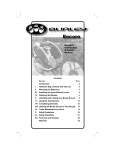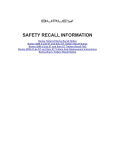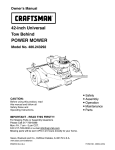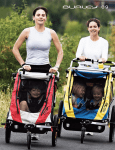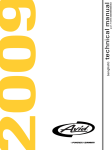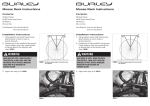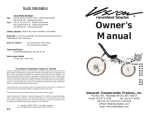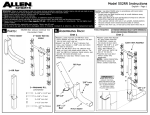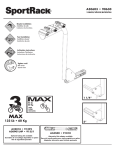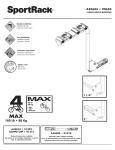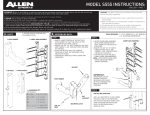Download Burley Recumbent Specifications
Transcript
Recumbent Bicycle Owner’s Instruction & Safety Manual Section Contents Page I. Introduction 2 II. Important Safety & Operating Information 3 III. Sizing Adjustments 5 IV. Assembly Instructions & Wheelbase Conversion 9 V. Suspension Tuning 15 VI. Accessories & Trailercycle/Trailer Towing 16 VII. Fastener Torque Specifications 17 VIII. Helpful Hints for Novice Riders 18 IX. Warranty 19 I. Introduction Congratulations! You have made a smart choice in selecting a Burley recumbent. Your new recumbent has been engineered to provide years of top quality performance, comfort and enjoyment. To show our confidence, we offer a lifetime warranty on the frame and fork and a 180-day warranty for other original equipment parts. [See warranty for details.) Complete the following for your own records: Date of Purchase: _______________________ Purchased From: _______________________________________________ (Retailer name and location) Model: ________________________ Serial #: ________________________ (located on right-rear dropout) Verify that you have received the following information with your new Burley recumbent: • Burley Adult Owner s Manual for Multi-Speed Bicycles • Recumbent Owner s Manual Supplement (This manual) • Warranty Card IMPORTANT: Read the Burley Adult Owner s Manual and Owner sManual Supplement thoroughly for important safety, maintenance and operating information. Keep the Burley Owner s Manual and Owner s Manual Supplement for future reference. If you loan or sell your bicycle, be sure to provide these instructions and allow enough time for new riders to read them carefully. CHECK YOUR BRAKE CABLE ENGAGEMENT: Before you begin every ride, or move the steering mast fore/aft, depress the front and rear brake levers to ensure proper brake cable engagement. Failure to do so could result in brake cables that are not properly engaged which could in turn result in an accident and serious injury or death. If you have questions or concerns about the length of your brake cables, contact your local dealer for assistance. 2 II. Important Safety & Operating Information Seat frame Seat base Tilt and height-adjustable steering mast Rear shock Suspension pivot Caution to New Recumbent Riders: The riding position and weight distribution on recumbents is quite different than on average “upright” bicycles and contributes to unique handling characteristics. Starting up from a standstill, turning at low and high speeds, and cornering and braking in wet weather will all be somewhat different from other bicycles. It is recommended that you become thoroughly acquainted with the handling and performance of your recumbent before riding among automobile traffic or other cyclists. BECOME FAMILIAR WITH HANDLING CHARACTERISTICS: Your Burley recumbent bicycle will handle differently from other bicycles. Do not ride this bicycle among automobile traffic or other cyclists before you are thoroughly familiar with its handling characteristics. Failure to do so could result in accident and serious injury or death. The addition of accessories, such as racks, trailers and trailercycles can affect the handling of your recumbent. Add these accessories only after you are thoroughly acquainted with your recumbent. Practice riding with these accessories in an open area free of automobile traffic. PRACTICE USING ACCESSORIES: The handling characteristics of your recumbent will change with the addition of loaded racks, a trailer or a trailercycle. Only add these accessories after you are completely familiar with the handling of your recumbent. Failure to do so could result in an accident and serious injury or death. 3 Rider Maximum Weight Restriction All Burley recumbents are engineered for a maximum rider weight of 275 lbs. (125 kg). DESIGNED FOR MAXIMUM RIDER WEIGHT OF 275 LBS.: All Burley recumbents are engineered for a maximum rider weight of 275 lbs. (125 kg). Individuals heavier than 275 lbs. (125 kg) should not ride these models. Failure to heed this warning may result in a frame failure which could cause an accident resulting in serious injury. Wheel/Heel Overlap Most recumbent bicycles exhibit some amount of front wheel-to-foot overlap when turning. This condition is described as the potential for the rider s foot to come in contact with some part of the front wheel while pedaling and cornering simultaneously. This condition is often noticed during low speed cornering, when the front wheel steering angle is greatest. It is important to become familiar with the extent of wheel-to- foot overlap, if any, with your recumbent bicycle. To familiarize yourself with this condition, test ride your bicycle in a safe, open space such as an empty parking lot. IMPORTANT: It is important to learn where front wheel-to-foot overlap can occur so that you will know how to avoid it. To avoid overlap, learn the technique of coasting through sharp turns. AVOID WHEEL-TO-HEEL OVERLAP: Most recumbent bicycles exhibit some amount of front wheel-to-foot overlap. A foot coming into contact with the front wheel may cause you to lose control of the bicycle, and may cause an accident resulting in serious injury or death. Handlebars and Forks Some Burley recumbent models are equipped with a special lightweight handlebar. This handlebar is designed specifically for recumbent bicycles and MUST NOT BE USED ON ANY OTHER BICYCLE. Handlebars of this type are identified by a warning label at the center of the bar. This warning label will be covered by the handlebar stem when installed on the bicycle. The warning label will be visible and obvious when the handlebar is removed from the handlebar stem. 4 DO NOT USE YOUR HANDLEBAR WITH ANY OTHER BICYCLE: Some Burley recumbent models are equipped with a special lightweight handlebar, identified by a warning label at the bar center. These handlebars are designed specifically for recumbent bicycles and MUST NOT BE USED ON ANY OTHER BICYCLE. Use of these handlebars on other bicycles may result in a failure, which could cause an accident resulting in serious injury. Some Burley recumbent models feature front forks with a protective plastic strip at the top of the right side fork leg. This strip is designed to prevent scratching or gouging damage to the fork from the drive chain. It is very important that these forks are not allowed to become scratched or gouged and that damage to the surface of the fork from the drive chain is prevented. It is very important that the protective strip is replaced if it becomes warn or damaged. See your dealer or call Burley Customer Service if you have questions about the fork in your bike. REPLACE PROTECTIVE STRIP ON FORK WHEN DAMAGED: Some Burley recumbent models feature front forks with a protective plastic strip at the top of the right-side fork leg. Damage to the surface of these forks could lead to the development of cracks, which could eventually cause the fork to fail. A fork failure will cause an accident that could result in serious injury or death. III. Sizing Adjustments Important Sizing Information for Proper Riding Position Recumbent bicycle sizing and fit criteria are different from upright bicycles. It is very important to carry out the necessary adjustments to be sure your recumbent fits you properly. A bike that does not fit properly is unsafe. It will be uncomfortable and difficult to control. FIT AND SIZE IMPORTANT: If your bicycle does not fit properly, you may lose control and fall. If your new bike doesn’t fit, ask your dealer to size it properly before you ride. Failure to do so may cause an accident, resulting in serious injury or death. Refer to the photo on page 6 for proper recumbent cycling riding position. Seat fore-aft position and handlebar position affect your comfort, safety and ability to control the bike. 5 Seat Track Adjustment The seat assembly is fixed to the seat track via quick-release mechanisms. It can be easily moved by opening the quick-release levers and sliding the seat on the track. The seat quick-release mechanisms must be fully closed before riding. If you have any questions about the proper operation of the quick-release mechanism, refer to Section IV. Tech, B.3, of the Burley Adult Owner s Manual for Multi-Speed Bicycles or have your dealer provide instruction. Under no circumstances should the bicycle be ridden without the seat quick-release mechanisms properly adjusted and fully closed. If the quick-release mechanisms are not closed with adequate force, the seat assembly may slide on the seat track. When the quick-release mechanisms are closed properly, the seat assembly WILL NOT SLIDE ON THE SEAT TRACK. If the seat assembly is allowed to slide on the seat track, it will not slide off the bike frame. Socket head bolts and special washers are installed at the rear of the seat track to prevent the seat assembly from coming off. These important safety features should not be removed from the bicycle. CLOSE QUICK-RELEASE MECHANISM AND ADJUST PROPERLY: Riding your bicycle with seat quick-release mechanisms open or improperly adjusted can cause you to lose control, resulting in serious injury or death. Seat Fore-Aft Adjustment Step 1. Seat Adjustment—While sitting on the bicycle, have an assistant hold you upright or lean against a wall. Pedal backwards in the freewheeling direction to position yourself on the seat and pedals. Stop pedaling with the crankarms parallel to the ground. There should be a slight bend to the knee of the leg on the forward pedal. If your leg is completely straight, the seat is positioned too far back on the seat track. If the bend at the knee is too great, the seat is positioned too far forward on the seat track. Step 2. Seat Adjustment Check—Confirm the correct bend of your leg by again sitting on the bike with the crankarms oriented parallel to the ground. Place the heel of your foot on the center of the forward pedal. Your leg will be absolutely straight when the seat is adjusted the correct distance from the pedals. This technique should provide a slight bend at the knee when the ball of your foot is centered on the pedal. 6 Steering Mast Adjustments The steering mast assembly features separate handlebar height and tilt angle adjustments. These adjustments will allow you to set the handlebars at the appropriate height and distance from your body. The correct adjustment will result in a 90° bend at the elbow (see photo on page 6). Steering Mast Height Adjustment 1. 2. Loosen the binder clamp at the bottom of the steering mast upper tube. Adjust the handlebars to the desired height and tighten the binder bolt. IMPORTANT NOTE: There is a minimum required insertion of the steering mast lower tube into the steering mast upper tube. This minimum insertion is required for proper strength of the steering mast assembly. Under no circumstances should the steering mast height adjustment be set so that the MINIMUM INSERTION mark on the lower tube is visible beneath the upper tube. ADJUST STEERING MAST PROPERLY: The MINIMUM INSERTION mark on the steering mast lower tube must not be visible below the steering mast upper tube AT ANY TIME. If the steering mast height adjustment is set beyond the MINIMUM INSERTION mark, the steering mast may become damaged or break, which could cause you to lose control and fall, causing serious injury or death. CHECK YOUR BRAKE CABLE ENGAGEMENT: Before you begin every ride, or move the steering mast fore/aft, depress the front and rear brake levers to ensure proper brake cable engagement. Failure to do so could result in brake cables that are not properly engaged which could in turn result in an accident and serious injury or death. If you have questions or concerns about the length of your brake cables, contact your local dealer for assistance. Steering Mast Tilt Range Adjustments It is a good idea to check the tightness of your steering mast pivot bolt before and after every ride. The steering masts on all 2004 recumbents (in this manual referred to as Type 2 steering masts) have only the rearward tilt range setting adjustment. Set the rearward tilt setting of the steering mast to the desired position by adjusting the adjustment bolt as described above. Some Type 2 offset stems feature a removable forward stop bolt. This bolt serves 7 to limit the extent to which the steering mast can be folded forward. If threaded inward (clockwise) completely or removed, the steering mast can be folded completely flat to rest on the bike frame. With the seat assembly removed and the steering mast folded flat, the bike may be easier to load into some vehicles. Type 2 Steering Mast Steering Mast Lower Tube Rear Tilt Adjustment Bolt Forward Tilt Stop Bolt Adjustment Lock Nut Once the seat and steering mast adjustments have been Offset Stem performed, the bike is ready to ride. However, there are other seat adjustments that may increase comfort and allow you to customize the fit of your bike. Fine Tuning Seat Adjustments for Comfort Seat Back Recline Adjustment The seat back recline is adjustable to several different position settings. Newer riders may prefer a more upright setting. Experienced and performance-oriented riders may prefer a fully reclined seat back. To adjust the degree of seat back recline: 1. Note the position of the seat assembly on the seat track. 2. Open both seat quick-release mechanisms. 3. Note the position of the plastic seat slider blocks in the range of adjustment holes provided. Note how moving the slider blocks to different adjustment holes changes the recline angle of the seat frame. 4. Slide the seat fully rearward and remove seat assembly from the frame. 5. Hold the seat in your lap or place it on a suitable work surface or table. 6. Remove both seat quick-release mechanisms, being careful not to lose the selfcentering springs. 7. Install the quick-release mechanism with plastic slider blocks and self-centering springs in the desired recline adjustment holes. 8. Install the seat assembly on the bike by sliding the seat onto the seat track from the rear (opposite of removal). Slide the seat frame to its original position on the seat track. 9. Close both seat quick-release mechanisms. (Refer to Section IV. Tech B.3, of the Burley Adult Owner s Manual for Multi-Speed Bicycles for proper quick-release mechanism operation.) Seat Bottom Fine Tuning Adjustments Seat Bottom Fore-Aft and Tilt Range Adjustments: The fore-aft and tilt range 8 adjustments enable you to change the distance of the seat bottom from the seat back, as well as the tilt angle of the seat bottom relative to the seat back. These adjustments will enhance your Seat Bottom comfort on the bike. Changing the seat bottom fore-aft and tilt range adjustments requires a 6mm hex wrench and a 13mm open end or box end wrench. 1. 2. 3. 4. Seat Back Seat Bottom Fixing Bolt Side Plate Seat Tilt Adjustment Holes Loosen the seat bottom fixing bolts. Slide the seat bottom to the desired fore-aft position within the seat frame side plates. Adjust the tilt angle range to the desired setting by raising or lowering the nose of the saddle. Tighten the seat bottom fixing bolts to 150-200 in/lb on a Corbin® seat bottom and 80-100 in/lb on a Burley© Seat bottom. IV. Assembly & Wheelbase Conversion Instructions NOTE: Burley recumbents MUST BE FULLY ASSEMBLED by your dealer. The following assembly information is intended primarily for the Dealer Technician performing this assembly. Forward Steerer Tube Locking Collar Some Burley recumbent models have a convertible wheelbase feature (identified by linkage steering with two headsets). Please review the following information regarding the forward Steerer Tube Locking Collar. Bikes with the convertible wheelbase feature utilize threadless (Aheadset™) style headset bearing assemblies, as well as one locking collar not included with typical threadless headsets. This locking collar is designed to act as both the spacer for the headset assembly and as a secondary retention device for the steerer tube. As with typical threadless headset assemblies, first adjust the bearing preload of the headset bearings and then tighten the locking collar bolt. The M5 bolt of the clamp should be tightened to 50–75 in/lb. IMPORTANT: The locking collar is only used in the medium wheelbase [MWB] setting [see wheelbase conversion instructions]. Linkage Assembly For bikes with the convertible wheelbase feature and linkage steering, please review the following linkage assembly information. 9 1. The linkage rod attaches the rear steerer to the front fork. Notice that one end of the linkage rod has the bearing and nuts tightened against each other with no gap. The other end has a gap and the nuts are tight. Also notice that the hardware necessary to attach the linkage rod to the brackets is installed on the linkage assembly. To install the linkage rod, you will need to remove the hardware. 2. Attach the side of the linkage rod with NO gap to the bracket on the fork using an M6 x 25mm bolt. IMPORTANT: The linkage rod must be installed to the bottom face of the mounting brackets on the fork and rear steerer tube. Place two flat washers between the bearing and the fork bracket. Tighten the bolt to 90-100 in/lb. 3. Adjust the linkage rod length so that the fork is centered and facing forward and the bracket of the rear steerer is perpendicular to the main frame of the bike. 4. Using a 10mm wrench, tighten one nut on the linkage rod against the bearing (11mm wrench). Tighten the other nut against the linkage rod. 5. Attach the linkage rod to the bottom face of the rear steerer bracket with one flat washer between the bracket and the bolt head and one flat washer between the bearing and the nut. Tighten the assembly to 90-100 in/lb. Wheelbase Conversion Wheelbase Conversion Some Burley recumbent models can be configured as either a short wheelbase [SWB] or medium wheelbase [MWB] recumbent. This feature provides two distinctly different handling characteristics. In the SWB setting, the bike delivers a quick-handling, sporty ride. In the MWB setting, the bike has a slightly slower steering feel and is smoother over bumps. Please review the following procedure to perform the wheelbase conversion on bikes with this feature. Such bicycles are assembled in the Medium Wheelbase (MWB) setting at the factory, hence these instructions cover the conversion from MWB to Short Wheelbase (SWB). 10 Special tools and knowledge are required to carry out the wheelbase conversion. The wheelbase conversion must be performed by your dealer. Conversion from Medium Wheelbase to Short Wheelbase Use the following procedure for conversion from the Medium Wheelbase (MWB) to the Short Wheelbase (SWB) setting: 1. 2. 3. 4. Remove the steering linkage rod. Note flat washer locations. Save the rod assembly for future reconversion to the MWB setting. Disconnect the front brake cable at the brake. The 160mm cable housing is used in the SWB setting. Remove the top cap and steerer tube clamp from the fork. The steerer tube clamp is not used in the SWB setting. Save it for future reconversion to the MWB setting. Remove the front fork from the forward head tube. Remove the steering mast assembly from the rear steerer tube assembly, leaving all cables intact. 5. Remove the rear steerer tube assembly from the rear head tube. 6. Install the fork in the rear head tube after repacking the headset bearing components if required. 7. Install the steering mast on the fork steerer tube. Adjust bearing preload and tighten the handlebar stem. 8. Connect the front brake cable and adjust the front brake. [Route the cable housing behind the rear head tube with the brake pipe oriented horizontally, facing rearward.] 9. Remove the forward headset cups from the forward head tube if desired.** 10. Recheck headset and brake adjustments and all fasteners for proper torque before riding. ** To keep from losing pieces, the rear steerer tube can be installed in the forward head tube. To do this, do not remove the headset cups. Install the rear steerer tube using the same headset assembly pieces, steerer tube clamp and linkage assembly. AUTHORIZED BURLEY DEALER REQUIRED TO MAKE CONVERSION: Some Burley recumbent models have a convertible wheelbase feature. The wheelbase conversion requires special tools and knowledge. This conversion should only be carried out by an authorized Burley dealer. Incorrect wheelbase conversion will result in improper adjustment of critical components such as headset bearings, steering linkage or brakes, and could cause an accident resulting in serious injury or death. 11 Corbin Seat Bottom Nylon Slider Blocks Pivot Block Pin Seat Frame Seat Bottom Fixing Bolt Seat Bottom Bracket Washer Lock Washers Seat Frame Side Plates QR Rod Pivot Block Self-Locking Nut Aluminum Slider Blocks Seat Bottom Assembly for Corbin® Seat Bottoms 1. Unpack the seat frame and the seat bottom from their separate packaging. Notice that the hardware for the seat bottom is installed on the seat bottom brackets. Also, the QR s and aluminum slider blocks are installed on the seat frame. To install the seat bottom in the seat frame you must first remove the hardware from the seat bottom brackets. This installation is easiest if performed before installing the seat frame on the bicycle. 2. Slide the seat bottom brackets between the two sides of the seat frame side plates. Install the pivot blocks from the inside by inserting the pivot block pin through the hole in the seat bottom bracket and then through the slot of the seat frame side plates. Install the large diameter washer onto the fixing bolt and insert the bolt (from the outside) through the slot in the seat frame side plates and seat bottom brackets and pivot blocks. Install the M8 nut onto the bolt with a 13mm wrench. Tighten the system to 150-200 in/lb. 12 Burley Seat Bottom Seat Frame Seat Bottom Fixing Bolt Seat Bottom Bracket Washer Pivot Block Seat Frame Side Plates QR Rod Self-Locking Nut Aluminum Slider Blocks Seat Bottom Assembly for Burley® Seat Bottoms 1. Unpack the seat frame and the seat bottom from their separate packaging. Notice that the hardware for the seat bottom is installed on the seat bottom brackets. Also, the QR s and aluminum slider blocks are installed on the seat frame. To install the seat bottom in the seat frame you must first remove the hardware from the seat bottom brackets. This installation is easiest if performed before installing the seat frame on the bicycle. 2. Slide the seat bottom brackets between the two sides of the seat frame side plates. Install the pivot blocks from the inside by inserting the a bolt with a washer through the seat frame, the composite seat bottom bracket, another washer, and then an M8 nut. Continue this process until all four seat block holes have bolts running through them. Tighten each bolt to 80-100 in/lb. 13 Cable Housing Lengths and Routing The cable housing lengths at the lower portion of the steering mast are set to fit the mast in an extended adjustment position. If the steering mast needs to be set close to the shorter end of the adjustment range, the housing lengths may need to be adjusted to avoid contact with other moving parts. ADJUST CABLEHOUSING LENGTH APPROPRIATELY: Cable housing may interfere with moving parts, such as the drive chain or lower handlebar stem, which may cause you to lose control and fall. Be sure to adjust cable housing lengths appropriately after making adjustments to steering mast extended length. TYPE 2 steering masts have cable housing stops at the left, or non-drive side of the fore-aft centerline. Both brake cable housings are routed to the rear pair of cable housing stops. Both gear cable housings are routed to the forward cable housing stops. Cable Routing for Type 2 Steering Masts (Steering mast upper tube shown) CHECK YOUR BRAKE CABLE ENGAGEMENT: Before you begin every ride, or move the steering mast fore/aft, depress the front and rear brake levers to ensure proper brake cable engagement. Failure to do so could result in brake cables that are not properly engaged which could in turn result in an accident and serious injury or death. If you have questions or concerns about the length of your brake cables, contact your local dealer for assistance. 14 Chain Routing Please refer to the photos below for proper routing of the drive chain. Single Idler Recumbent Chain in front Chain in rear Nasoke with two idlers V. Suspension Tuning Burley Nasoke and Spider recumbents are equipped with rear suspension featuring a custom-tuned air shock. This shock absorber is adjustable to provide proper suspension performance for a wide variety of rider weights and riding preferences. Refer to the enclosed literature from the manufacturer for adjustment specifications. IMPORTANT: This shock is only rated to 300 psi. Do not exceed 300 psi in your Cane Creek shock. Damage to the shock may result! Suspension Pivot The suspension pivot assembly is designed to provide years of maintenance-free performance. The pivot should never exhibit any play or "slop". If you have any questions about the condition of the suspension pivot, do not ride the bicycle. Have your dealer inspect the suspension pivot. 15 VI. Accessories and Trailer Towing Accessories Several accessories are available from your Burley recumbent dealer which will add to the enjoyment and utility of your recumbent. Kickstand Adaptor: This kit enables easy installation of rear mount-type kickstands to all Burley recumbent models. Workstand Adaptor: Designed for the professional and home mechanic, the Workstand Adaptor engages the recumbent seat track and provides for easy fixturing of the recumbent to a conventional bicycle workstand. Rack Installation Kits: Rack Installation Kits adapt most popular touring racks, including the Moose Rack™, to fit Burley recumbents. See your dealer for the Rack Installation Kit for your model. Alternative Hitch: To pull a Burley child or cargo trailer, use the quick-release Alternative Hitch with all Burley recumbents. Rear Rack Installation and Use Rear touring racks may be used with Burley recumbents. A Burley recumbent rack installation kit will be necessary to install a rear rack to your recumbent. Rear racks install to the forwardmost threaded boss on the chainstay or the swingarm of the recumbent frame and to the dropout eyelet near the rear wheel axle. See your dealer for the installation kit for your Burley recumbent model. Trailer Towing Burley child and cargo trailers may be towed by a Burley recumbent. Use of the Burley Alternative Hitch™ is required. See your Burley Dealer for information about the Alternative Hitch. IMPORTANT: It is very important that you read the Burley Trailer Owner s Manual thoroughly for important safety, maintenance and operating information 16 VII. Fastener Torque Specifications Suspension pivot retaining bolt 90-100 in/lb. Strut fixing bolts 50-65 in/lb. Swingarm strut and rack mount bolts 50-65 in/lb. Steering linkage rod attachment bolts 100–120 in/lb. Upper shock mount bolt 150–200 in/lb. Lower shock mount bolt 150-200 in/lb. Idler wheel mount bolt 150–200 in/lb. Corbin seat bottom fixing bolts 150-200 in/lb. Burley seat bottom fixing bolts 80-100 in/lb. 17 VIII. Helpful Hints for Novice Riders 1. Your foot should be positioned with the pedal under your arch, not under the ball of your foot as with most bikes. 2. The amount of seat back recline is a matter of personal preference. A more laid back position distributes body weight over a larger area and is most comfortable for longer rides. An upright position is more comfortable for most beginners, and makes looking over the shoulder much easier. 3. The steering mast can be adjusted for height and lean-back. If it s set too high the handlebar may obstruct your view; too low and your knees may hit your hands. A 90° bend at the elbows with the bar ends pointing down and slightly forward is a common setting. 4. Starting off from a standstill requires a good push on your first pedal stroke to gain some momentum for balance. Place the pedal at the top of the stroke (12 o clock) on your strong side. Choose a low gear. 5. It takes very little input from the handlebars to steer the recumbent. Relax your upper body, particularly your shoulders, arms and hands. Failure to do so is a common problem for beginning riders. 6. You will be pushing against the seat back as you pedal. Try to focus the effort to your middle back for more power. Avoid pulling on the handlebars. 7. Try to develop a smooth, circular pedal stroke. IX. WARRANTY Burley Bicycle Limited Warranty Burley will repair or replace any original equipment parts it determines to be defective for a period of 180 days from date of purchase at no charge; the frame and fork have a lifetime warranty. The owner of a Burley bicycle must present his/her bicycle for repair, within the warranty period, at an authorized Burley dealer, together with an original sales receipt or similar proof of purchase. This warranty applies only to the original owner and is nontransferable. This warranty does not apply if the recommended weight limit for Burley recumbents is exceeded. Burley cannot be responsible for failure due to improper assembly, modification of parts or instructions, neglect, abuse, accident, and/or normal wear. The warranty does not cover any bikes used for rental, competition, or commercial use. Burley neither assumes nor authorizes any person to assume any other liability in connection with Burley bicycles, and there are no oral agreements or warranties collateral to or affecting this agreement. Any implied warranty of merchantability or fitness for a particular purpose is limited in duration to the duration of this warranty. Some states do not allow a limitation on how long an implied warranty lasts, so the limitation may not apply to you. This warranty gives you specific legal rights and you 19 About Burley Design Cooperative Burley has been supplying products to the bicycle industry since 1975. Burley products are designed and manufactured at our Eugene, Oregon shop. As workerowners of our cooperatively owned business, we bring an uncommon degree of personal pride and attention to our work. Use our products with confidence and satisfaction! Burley Design Cooperative • 4020 Stewart Rd. • Eugene, OR 97402 USA (541) 687-1644 • Fax (541) 687-0436 • www.burley.com [email protected] Copyright ©2004 by Burley Design Cooperative “Burley” is a registered trademark of Burley Design Cooperative Printed on recycled paper rev 10/04




















